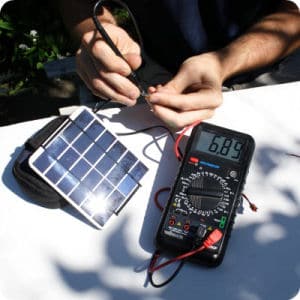
Measuring the Power of a Solar Panel
How To Measure the Output Power of a Solar Panel
![]() When measuring the power of a solar panel the use of a digital multimeter is required to measure the voltage and amperes being generated by a panel under different light conditions. Knowing the power output of a particular photovoltaic panel is an important requirement of any solar system.
When measuring the power of a solar panel the use of a digital multimeter is required to measure the voltage and amperes being generated by a panel under different light conditions. Knowing the power output of a particular photovoltaic panel is an important requirement of any solar system.
As we have seen throughout this website, solar power is a renewable form of electrical energy generation that is commonly created using photovoltaic solar panels, either individually or connected together in strings to form larger solar array’s.
Understanding the way that photovoltaic (PV) solar panels work is a basic requirement as most people assume, rightly or wrongly, that just because they have purchased a 100 watt solar panel, it will deliver 100 watts of electrical power continuously all day. However, in reality this is not always the case as the electrical power delivered at a certain instant in time during the day is a direct function of positioning and the weather conditions.
Sunlight is an intermittent energy source constantly changing throughout the day so photovoltaic solar panels have to be able to operate under these varying conditions. As the efficiency of a solar panel is the ratio of electrical power output to the amount of sunlight, that is solar irradiance absorbed by the panel.
Therefore it is important that the solar panel orientation is correct to receive the maximum amount of sunlight throughout the day. Larger panels have the capability to produce more electrical power than smaller PV panels for a given solar irradiance.

The performance of photovoltaic solar panels can be determined by measuring the relationship between the panels voltage, current, and therefore power output under different meteorological conditions, such as total solar irradiance.
Inclination of the panel, ambient air temperature as well as panel temperature all play an important role in the output power of a solar panel.
Manufacturers rate their photovoltaic panels based on the DC output power at an irradiance of 1000 W/m2 (full sun) and a panel temperature of 25oC in order to get you to buy their product.
A standard 12-volt PV panel will generate a maximum terminal voltage of about 20 volts in full sunlight with no connected load. However in the real world, photovoltaic solar panels operate below these ideal settings resulting in the output power of a solar panel being much less than the PV panels possible maximum output power rating.
So how do we measure the output power of a photovoltaic solar panel. Well in its most basic of terms, the output power (P) of the solar cell is obtained by multiplying the output voltage (V) by the output current (I) at maximum power conditions, giving P = V x I which itself is the basis of Ohm’s Law
Solar Panel Power Output
The output power of a typical solar panel depends very much on the electrical load connected to it. Maximum power is transferred when the panel’s (or array’s) dynamic resistance equals that of the connected load. The simplest load for a pv panel to supply current too is that of an electrical resistance such as a DC water heating element. As Ohm’s Law describes the relationship between the voltage across and the current flowing through a resistor, we can use a simple resistance to measure the power of a solar panel.
Solar panel I-V Characteristic Curves are used to give a visual representation of the current and voltage ( I-V ) characteristics of a particular photovoltaic panel (cell or array) giving a detailed description of its solar energy conversion ability. Knowing the electrical I-V characteristics of a solar panel is critical in determining the output performance and therefore its efficiency. Measuring the output power of a solar panel, for example the 100W, 12V Renogy Solar Panel is not that difficult if we apply some simple steps.
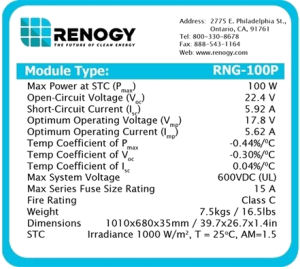
The product label of the Renogy 100 Watt 12 Volt Polycrystalline Solar Panel gives us the electrical characteristics of the panel, according to the manufacture Renogy when it is exposed to an irradiance of 1000 W/m2. But what does it all mean.
Our electrical data label states that the panels Open Circuit Voltage, (VOC) is 22.4 volts and that its Short Circuit Current, (ISC) is 5.92 amps.
So we can use Ohm’s Law then to find the output power of the solar panel, right!. But the voltage, V times the current, I will give us 22.4 x 5.92 = 132.6 watts, which is a lot more than the 100 watts quoted by the label. So what’s going on?
The open-circuited voltage, VOC means that the PV panel is not connected to any load, so its terminals are therefore open (infinite resistance) resulting in maximum voltage, in this case 22.4 volts, at its terminals. As its terminals are open there will be no current flow (I = 0) because there is no electrical circuit or load for the current to circulate through. Then the output power of the solar panel in this instance is P = V x I = 22.4 x 0 = 0 watts. In other words no generated electrical power.
Likewise, the short-circuited current, ISC means that the PV panels terminals are shorted or connected together (zero resistance) creating a fully closed electrical circuit allowing maximum panel current, in this case 5.92 amps, to flow. However, as the terminals are shorted together there will be no output voltage drop (V = 0), so the output power of the solar panel will be P = V x I = 0 x 5.92 = 0 watts. Again no generated electrical power.
Then we may think that this Renogy solar panel can generate 132.6 watts of solar electricity, in reality it can not. Photovoltaic panels provide usable electricity when connected to an electric load and by measuring the output of a solar panel, we can use Ohm’s Law to determine the maximum output power point, or MPP.
Measuring the Power of a Solar Panel
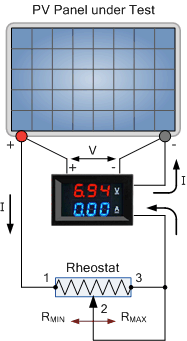
We said previously that the output power of a solar panel mainly depends on the electrical load connected to it. This load can vary from an infinite resistance, (∞Ω) to a zero resistance, (0Ω) value thus producing an open-circuit voltage, VOC at one end and a short-circuit current, ISC respectively, at the other. Then we need to be able to find an external resistive value somewhere in between these two extremes.
As the theoretical maximum power, Pmax was shown to be 132 watts, and the maximum open-circuit voltage, VOC as 22.4 volts. If we assumed the panel has a maximum wattage of 150 watts and a maximum terminal voltage of 30 volts, this would give us the panels dynamic resistive value of:
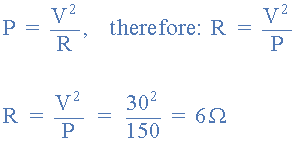
There are many ways to achieve this 6.0 Ohm value using fixed value resistors, to variable resistors, to rheostats. The option used would depend on what’s available and budget, as large power resistors can be expensive. In the example given, the load resistance will be achieved using a Rheostat, thus giving us a fully variable resistance between a minimum value of zero Ohms (0Ω) and the maximum value of 6Ω. We know that our solar panel has a manufacturers rating of 100 watts, so this would be the minimum power rating of our rheostat.
To measure the voltage across the terminals of the PV panel we would require a voltmeter. This could be a digital or analogue multimeter or a simple voltmeter but must have a scale high enough to read the panels open-circuit voltage (VOC). The type used would depend on what’s available and budget.
Measuring the current generated by the PV panel would require an ammeter to measure the short circuit current (ISC) into a dead short. Again this second meter could be digital, analogue or a multimeter depending on what’s available and budget.
Although we have calculated the maximum resistive value required above as being 6Ω, chances are we would not be able to purchase one at the exact 6Ω resistive value. So let’s assume that we bought a 10Ω rheostat which is fully variable from between 0 and 10 Ohms.
This would allow us to increase the externally connected load resistance in 10 steps of 1 Ohm each, while at the same time measuring the solar panels output voltage and current. Then we can complete the following table of our results to determine the electrical power supplied by the PV solar panel for different values of load resistance.
Table of Measured Results for our Solar Panel
| Resistance (in Ohms) | Voltage (in Volts) | Current (in Amperes) | Power (in Watts) |
|---|---|---|---|
| Open Circuited | 22.4 | 0.00 | 0.00 |
| 10 | 22.4 | 2.24 | 50.2 |
| 9 | 22.3 | 2.47 | 55.1 |
| 8 | 22.1 | 2.76 | 61.0 |
| 7 | 21.6 | 3.08 | 65.9 |
| 6 | 20.80 | 3.50 | 72.8 |
| 5 | 20.05 | 4.01 | 80.4 |
| 4 | 18.80 | 4.70 | 88.4 |
| 3 | 16.86 | 5.62 | 94.7 |
| 2 | 11.60 | 5.80 | 67.3 |
| 1 | 6.0 | 6.00 | 36.0 |
| Short Circuited | 0 | 5.92 | 0.00 |
Having taken our readings and tabulated the results in the above table, we can clearly see that the maximum power occurs when the load resistance RL has a resistive value around the around the 3 Ohms value. At 3Ω’s the panel produces a current of 5.6 Amperes at about 16.9 volts, thus giving a calculated output power of 94.7 watts.
This value closely matches the manufactures data label for an operating voltage (Vmp) and operating current (Imp) of 17.8V and 5.62A respectively giving a dynamic panel resistance at maximum power of Vmp/Imp = 17.8/5.62 = 3.17 ohms. We could if so wished fine tune our measurements to get voltage and current values even closer to the 100 watt, 3.17 ohms target.
It therefore shows for our simple example that the maximum power is generated by the panel around this 3.17 ohms point and matching panel resistance to load resistance results in maximum power transfer from panel (or array) to load and therefore, increased efficiency.
Using the data from the table above, we can plot a graph of the measured voltage against the panels current as shown.
I-V Characteristics Curves
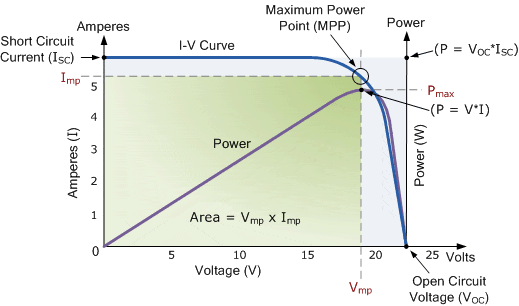
Above is the I-V characteristics graph for our PV solar panel example and is typical for all PV solar panels. Measuring the power of other types and ratings of solar panel will produce similar results, just the voltages and current values will be different. Also notice that power is zero for an open-circuit (zero current condition) and also for a short-circuit (zero voltage condition).
The maximum power output of a PV panel can be defined as its peak DC output given by multiplying the voltage and the current. Here the optimum operating point for our solar panel is shown at the mid-point in the bend (or knee) of the characteristics curve. In other words, this is the point at which the solar panel generates its maximum power, known commonly as the maximum power point or MPP.
The I-V characteristics curve presents an important property of a photovoltaic solar panel, or cell in that it shows it to be a current source device rather than a voltage source device, like a battery. However, unlike a battery which has a constant terminal voltage, (12V, 24V, etc.) and provides variable amounts of current to a connected load, the photovoltaic cell or panel provides a constant supply of current over a wide range of voltages for a given amount of solar insolation.
Measuring the Power of a Solar Panel Summary
Measuring the power of a solar panel is not too difficult but requires an assortment of digital multimeters, power resistors, or a single rheostat capable of handling the generated power. We need to remember that the greater the power output of your panel. For example, 200W, 285W, 330W, etc. the greater will be the voltages and currents and therefore safety is important.










Check out this soon to be launched product that can test if a panel is within factory STC label specs without need of rheostat, just a digital clamp meter, its sensor and app is all that’s needed.
Hi, I have a 1600w 24v investec inverter, 6x 12-100HR and a 450w solar panel, the panel is unable to fill up this batteries, what do I need to do?
Add more solar panels. One single 450w panel is not enough
Ha
Great detailed explanation of PV parameters. In your example of a 100w panel would charging a 12 volt battery be more efficient with a direct connection to such a solar panel compared to PWM or MPPT? Thinking about this, and a little bit of guessing PWM is just a direct connection with hysteresis that allows connect and disconnect at the required voltages and because it is working at <17.8V then there is already a degree of inefficiency, But a good MPPT charger will provide the correct resistance to obtain the MPP, 17.8V 3.17ohms and use an efficient switch mode to charge the battery. So direct connection is the same as PWM? But how do I test that a particular MPPT charger is more efficient? Thanks
Pulse Width Modulation, or PWM for short, is a technique of sending very short ON/OFF cycles (pulses) several hundred times per minute to control the magnitude of the output voltage. It is called “pulse width” because the width of the pulses may vary from a few microseconds to several seconds. Photovoltaic (PV) panels produce an almost constant DC output voltage and not a PWM output. Then you are incorrect in your assumption that PWM is just a direct connection with hysteresis. Battery charge controllers commonly use PWM to regulate a batteries charging current and float charge current keeping the batteries fully charged without overcharging them.
Since both the battery terminal voltage and the PV output voltage can vary during use due to the batteries state-of-charge during charging, temperature and PV insolation variations throughout the day. Direct connection of a PV panel to a battery leads to mismatch and therefore energy losses. The algorithm of MPP trackers measure the currents, voltages or the power of the PV panel/array to establish the optimum operating voltage. Therefore, it is able to react to changes in the photovoltaic panels/array performance.
Thank you for this information.
What is the relationship between short circuit current and solar energy?
Is this linear?
Can a small solar panel be used as a sensor to measure solar energy using short circuit current?
Short-circuit current, Isc is the current through the solar cell when the positive and negative terminals of a photovoltaic solar cell are shorted, thus resulting in zero voltage output from the cell. Isc is the largest current value which can be delivered by the pv cell. Clearly, Isc is directly dependent on the light intensity as no sunlight, no current. Then Isc is not linear.
So this Arduino Irradiation Meter cannot work then?
It would make for an interseting school project, but not very accurate at low light levels. As explained previously, short-circuit current, Isc represents the maximum cell output current when the output leads are shorted and the voltage developed by the cell almost vanishes to zero (V = 0). It is assumed Isc is directly proportional to the radiant energy intensity and yes, increasing the irradiance increases the magnitude of the short circuit current, but not in a linear fashion as suggested. This is because at V = 0 Isc = the cells light-generated current depends on the solar cell structure, material properties, spectral response and the operating temperature. Commercial light sensors use photodiodes which linearly measure irradiance.
I have seen many I-V curves for solar panels and these all seem to show a linear relationship between I and solar irradiance up to about 70% of maximum current, at which point the I-solar energy plot begins to curve a lot.
I do wonder if there is a mathematical relationship for this curve that could be used to produce an I-solar energy result for a small solar panel, a relationship that could be applied to *all* solar panels of the same type (e.g. mono-crystaline, etc).
That would allow a small solar panel of a particular type to be used as an effective solar energy sensor.
However if this curve is particular to every solar panel, then such a sensor would not be possible without ‘calibrating’ each small panel.
Thenks a lot for the lesson
Thank you for the article. I need to point out one flaw, however, so that people can make the proper calculations on their own.
Based on Joule’s Law (Power = Current * Voltage), power divided by voltage equals current, NOT resistance. Using Ohm’s Law and Joule’s Law, resistance equals voltage-squared divided by power (R=V²/P). Therefore, in your assumption of 150W and 25V, the resistance would be calculated as 4.17 ohms (25²V / 150W), not 6 ohms.
Fortunately, your incorrectly calculated value of resistance was close enough to the proper value to allow you to identify the proper resistance range of 0-10 ohms, so your results did not suffer from the mis-calculation. If the assumed values for power and voltage were much higher, say for an array of panels connected in series, then the resulting resistance would have be way off.
Like I said, I do appreciate your article. I just want your readers to have the correct formulas so that their results are as accurate as possible.
Thanks. The error was we wrote 25 volts by mistake and not the 30 volts as per our original notes, which would give a dynamic resistance of 6 ohms
Hello. Very valuable analysis, thank you. We want to power a 230v 2.5 Kw mains immersion heater (straight resistive load of about 10 ohms at the bottom of a thermal store) with approx 240v DC from a string of panels. The latitude is 59 north roof slope 20 degrees facing due south.
Total output will be poor in winter because of the latitude but summer days are long and that is when the hot water is needed.. I see that output voltage is fairly constant and current varies with sun power. The DC switching will use a dedicated high voltage and power DC relay. Itself controlled by a much smaller current through the immersion heater’s thermostat. Do you see a problem with this?
Yes, many. Firstly, ordinary resistive heating elements will work with DC power as: 230 Vrms = 230 VDC. Relay contacts switching DC power will arc more than switching AC power. Element size (resistance) needs to have an approximate match to the PV array (Vmp/Imp) for maximum power transfer, for example. Let’s assume you are using standard 250 watt photovoltaic panels:
Maximum power per panel at full sun (1000W/m^2) of solar insolation is: 250 watts
Typical voltage at Maximum Power (Vmpp) for a 250W PV panel is about: 30.45 V
Typical current at Maximum Power (Impp) for a 250W PV panel is about: 8.21 A
Therefore panel resistance at full sun = Vmp / Imp = 30.45V / 8.21A = 3.71 ohms minimum per panel. Changes in solar irradiance will vary this value.
Heating element rated wattage = 2.5kW = 2500W
Heating element resistance: R = V^2 / P = 230 * 230 / 2500 = 21.2 ohms (not 10 ohms)
Ideal number of panels per single string assuming 1000W/m^2 of full solar insolation is: 21.2 Ohms / 3.71 Ohms = 5.71 panels, that is maximum power transfer will occur with 5.71 pv panels, but we will round this down to 5 whole panels per series string, (better down than up).
Thus a 1250 watt (5*250W) system, 5 panels times 1 series string will have a resistance of: R = V / I = (30.45 * 5) / 8.21 = 18.54 ohms. String voltage = 5 * 30.45 = 152.25 volts. 1250 watts of installed panels in bright sunlight for maybe 3.5 hours to 4 hours per day translates to about 4.4 kWh per day of DC power into the water heaters resistive element at full sun.
Or upgrade to 20 panels, 10 panels per string times 2 strings, gives a resistance of: (30.45 * 10) / (8.21 * 2) = 18.54 ohms (same dynamic resistance as above). This will give a string voltage of about: 10 * 30.45 = 304.5 volts and 2500 watts of panel wattage (equivalent to your heating element wattage) which equates to about 8.8 kWh of DC current per day of solar power.
Other PV panel wattages will have various Vmpp and Impp specifications (and thus different dynamic impedancies) obtaining different heating results when matching series panels with the resistance of your 2500W heating element.
Option 2), Use a low voltage 24 or 48 volt heating element to reduce wattage and number of panels, or accept lower temperature water.
Option 3), Use a solar thermal hot water panel to heat, or at least pre-heat the water. This could give you about 4 times the heat for the same square footage of panel area used than for a PV panel. Solar thermal is a more cost effective way to heat water.
Option 4). Use a Hot Air Heat Pump to give hot water 24 hours a day, rain or shine.
does the number of watts determine the panel size
Quick answer, kind of.
Long answer, it will affect it along with an other parameter, the efficiency rate. The efficiency rate is determined by the type of cells (mono vs polycristaline), the technology used to create ce cells and the quality of the materials.
So a low quality 100w polycristaline cheap solar panel at 17% efficiency will be bigger than a 100W quality monocrystaline solar panel at 22% efficiency (i believe the surface would need to be about 5% smaller, but there’s more elements to consider…)
So theres more than the watts.